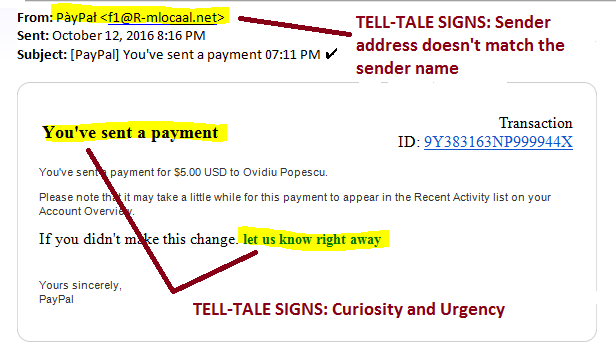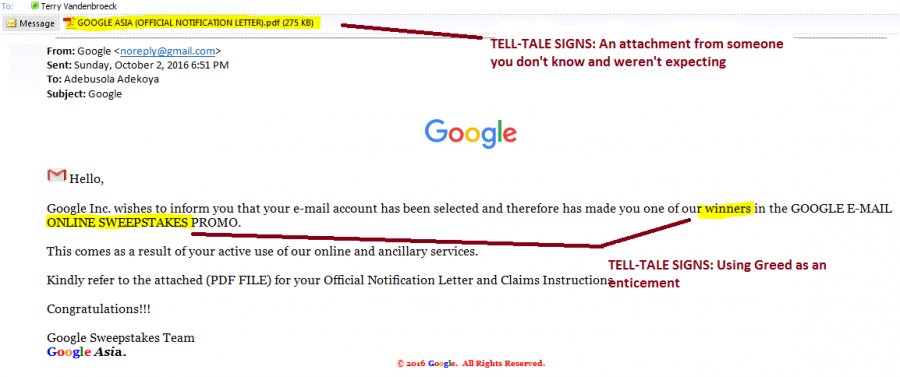Email security
Perpetrators use email as an attempt to steal your personal information. Discover how to spot malicious messages and report them. Learn how Microsoft's email security solution safeguards your Outlook Inbox.
Phishing
What is phishing?
Phishing is a form of theft where someone attempts to steal your sensitive personal information by pretending to be a trustworthy party in an electronic communication (usually by email). Phishing messages are designed to confuse you by making them look like they are from a trusted business, bank, government agency or even the University of Manitoba.
Falling victim to a phishing message could leave you vulnerable to identity theft and severe financial losses.
How to protect yourself against phishing attacks:
The best way to protect yourself is to learn how to recognize them. Most phishing messages usually share some common traits. Learn how to spot them:
- UM external warning tag. This is a warning at the top of any email that comes from outside the university. This is a sure indicator that if it sounds suspicious, it probably is.
- A sense of urgency: Phishing attempts tend to immediately try to bring out an emotional reaction from you like greed, curiosity and fear. Phishing attempts also often sound urgent.
- Poor spelling and bad grammar: Odd tone, bad grammar, spelling, or unfamiliar email signatures or sender addresses are clear signs of phishing.
- Strange or incorrect URLs: Beware of phishing email elements like attachments or links to unfamiliar login pages.
- Tone and context: Do you typically receive these kinds of requests?
Don’t fall prey to fishing attacks. For the latest news on phishing attempts, check our security alerts page.
Spam
What is spam?
Spam is unsolicited junk email normally with sales or advertising content. Spam email messages use methods similar to phishing messages to draw you in.
Not only is spam annoying, it can also be a security threat. For example, a spam email can disguise itself as an advertisement for a trusted company or organization when it is actually trying to trick you into entering your personal information or downloading a harmful program.
UM email security with Microsoft Defender
The University of Manitoba uses Microsoft Defender for Office 365 as its email security solution.
What is Microsoft Defender for Office 365?
Microsoft Defender for Office 365 is a security email service that protects UM accounts from malicious phishing campaigns, marketing spam, malware and more. Using Microsoft's machine learning and artificial intelligence (AI), MS Defender provides greater email security and protects you from the latest email threats.
How does Microsoft Defender work?
MS Defender filters and places the messages you receive in your inbox, Junk Email folder or Quarantine. You can help Defender improve its identification process by flagging phishing and spam messages in your inbox.
Malicious email
Defender places messages believed to be phishing or another threat in a security quarantine. You will be emailed a quarantine report notifying you of messages delivered to your Quarantine. Check these reports regularly to ensure that legitimate messages are not marked malicious.
See the "How to Release Legitimate Email from Quarantine" section below for more details.
Spam
Unsolicited advertisements, newsletters, or other messages sent in bulk will be sent to your Junk Email folder in Outlook.
Graymail
Solicited bulk email messages that do not fit the definition of email spam (e.g. the recipient "opted into" receiving them) will be sent to your Junk Email folder. If you opt in to newsletters, advertisements, or any other email that fits the definition above, you must select "It's not junk" on the message in your Junk Email folder to send it back to your inbox. Future messages from the sender will go to your inbox.
Missing email
If you have not received an expected email, check both your Junk Email folder and Quarantine to see if the email was identified incorrectly.
Check your Junk Email folder
Messages identified as spam or graymail will go to your Junk Email folder.
It is important to check your Junk Email folder regularly because Outlook will delete junk email 30 days after you receive it.
How to check your junk email
- Look for a folder called “Junk Email” in Outlook.
- Scan through the messages in your Junk Email folder and look for any that seem relevant or interesting.
- If you find a message that you want to keep, you can move it to your Inbox by selecting It’s not Junk at the top of the message.
It’s not junk: Choosing this option when a message has incorrectly been sent to the Junk Email folder will move the message back to your Inbox and update Microsoft to make sure you receive messages from this address in the future.
Check your Quarantine
Messages identified as malicious will to to your MS Defender Quarantine.
You will receive email messages from Microsoft 365 Security (quarantine@messaging.microsoft.com) notifying you of incoming messages that have been marked as malicious. Check these messages regularly, as they may be blocking emails that you were expecting to receive. At any time, you may review any messages being held in quarantine by going to https://security.microsoft.com/quarantine.
How to release legitimate email from quarantine
To release falsely held messages from quarantine:
- Open a web browser and navigate to https://security.microsoft.com/quarantine, or you can click the Review button in the quarantine report that you receive in your inbox.
- Sign in using your UM email address and password (Doing so will result in a prompt from Entra MFA).
- Once signed in, you can then select the messages that you wish to release and choose the Request Release option.
What does “Request Release” mean?
Email classified as malicious with high confidence requires administrative approval prior to releasing the email. The "Request Release" option notifies our Information Security and Compliance team to review your request and approve it if the detection is considered a false positive. If you have specific questions about your release request, please email spam@umanitoba.ca.
How long are quarantined messages kept?
Defender keeps quarantined emails for 30 days from the received date, and then the message is deleted. Once emails have been deleted from quarantine, they cannot be retrieved.
Report phishing or spam
Microsoft's integrated email security system includes Outlook buttons to report phishing or spam messages.
The new desktop version of Outlook and Outlook on the Web offers Report Phishing and Report Junk menu options.
Report Phishing
Select Report Phishing when you think you have received a dangerous or suspicious email. The messages you report using the Report phishing button will be automatically
- Moved to your Deleted Items folder
- Forwarded to the IST security team
- Forwarded to Microsoft to improve filtering
You can block nuisance email, such as spam or marketing messages in Outlook by right-clicking on the email and selecting Block Sender.
A suspicious email can also be reported by forwarding it to spam@umanitoba.ca.
Report Junk
Select Report Junk when you have received an unsolicited or unwanted email. This option moves the message from your Inbox and places it in your Junk Email folder. A copy of the message may be sent to Microsoft to help update their filters.
Check your Outlook email quota
Contact us
Call or chat
Monday to Friday, 8 a.m. to 8 p.m.
Call 204-474-8600 or use our new 'Chat with us' bubble at the bottom right corner of this site for a faster response via text or call.
To report a critical system outage after hours or on weekends and holidays, call 204-474-8600 and press 2.
IST Service Desk walk-in service
123 Fletcher Argue
University of Manitoba, Fort Garry
Hours: Monday to Friday, 8 a.m. to 6 p.m.
Join the queue: Fort Garry WaitWell
230 Neil John Maclean Library
University of Manitoba, Bannatyne
Hours: Monday to Friday, 8 a.m. to 4:30 p.m.
Join the queue: Bannatyne WaitWell




